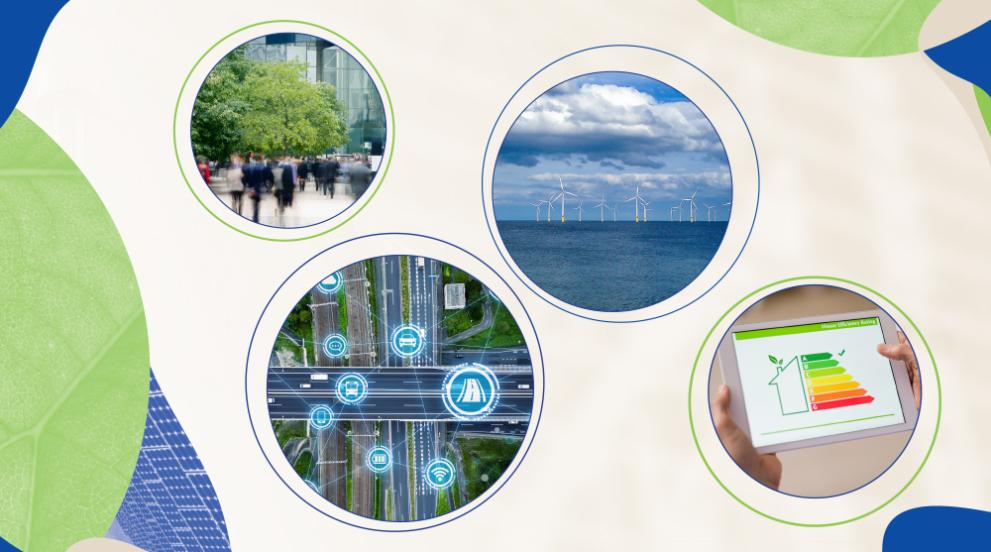
More than 10 years ago, the EU was the first economy in the world to set legally-binding targets for addressing climate change. Since then, more than 200 other countries have followed this concept and have themselves set targets in the fight against global warming. Indeed, by providing a clear sense of direction, the concept acts as a key driver for investment in clean energy technologies. Not only does this help move towards the energy and climate targets, but by achieving more impressive economies of scale, it also helps bring down production costs and encourages further research and innovation.
| EU Targets | 2020 | 2030 |
|---|---|---|
| Emissions reduction | 20% | 40% |
| Share of renewables | 20% | 32% |
| Energy efficiency | 20% | 32.5% |
Following the Paris Agreement in December 2015, the EU sought to look further ahead, acknowledging the long-term nature of the necessary changes. In 2018/2019, the EU agreed the Clean energy for all Europeans package - a complete overhaul of EU energy legislation, which also defined binding energy and climate targets for 2030. As part of this process, EU countries have established another ground-breaking framework – a comprehensive plan outlining how each country intends to fulfil its climate goals in the next 10 years, starting from 2021. The concept is called thenational energy and climate plan (NECP).
Defined under the Regulation on the governance of the energy union ((EU) 2018/1999), the NECPs were established as part of the Clean energy for all Europeans package. They require each Member State to outline its 10-year plans for reducing emissions, increasing the take-up of renewables, improving energy efficiency (including in buildings), raising cross-border infrastructure/ interconnections, ensuring markets are fit for new technologies, and boosting research and innovation, as well as outlining main priorities looking further forward to ensure coherence with the 2050 climate neutrality objectives. The process of drafting the national plans was required to be as inclusive as possible, including different forms of consultation in each country.
Better coordination
One important new aspect is the idea that the national plans need to be well-coordinated across all government departments, so that all aspects of government policy and investment move in the same direction. This should prevent the occasional situation where one Ministry appears to be supporting a policy direction that contradicts the policy in a different Ministry.
Moreover, requiring each EU country to draw up and publish similar plans raises the potential for synergies and cooperation between neighbouring countries. The key point is that individual countries are able to develop a climate and energy perspective for the next 10 years, which also takes into account what their neighbours are doing.
A transparent and inclusive process
With Member States having submitted their draft NECPs in early 2019, the Commission presented in June 2019 a detailed assessment of the cumulative impact of all the draft plans in all the different areas targeted. This included country-specific recommendations by the Commission, suggesting ways in which these draft plans could be revised to make potential improvements and efficiency gains in order to achieve our common objectives. In short, it moved the draft NECPs out of a purely national perspective, into an EU-wide context, providing a European dimension. By highlighting the direction of travel at EU level – and providing regular progress reports as we move forward - the NECPs are expected to provide a boost for investment on a truly continental scale.
Taking account of the recommendations last summer, Member States were required to finalise their NECPs by the start of this year. The Commission is now carrying out a thorough assessment of the final NECPs from a national perspective, but also in terms of the cumulative impact of 27 different NECPs in all the different policy areas, and especially for EU binding targets of renewables and energy efficiency. This analysis, which may include further recommendations, is due for publication in the autumn.
All in all, by enabling EU countries to gather all energy and climate related targets, monitoring and reporting under one heading, following a common template, the NECPs are of key importance to driving the clean energy transition. They are able to lock in Member State commitments, and avoid slippage as we move forward. Moreover, the NECPs will form a key building block as the EU looks to increase our ambition under the European Green deal in order to achieve carbon neutrality by 2050.
Importance of NECPs for post-Covid investments
One further advantage of the NECP concept is that Member States have publicly stated their intended pathway for pursuing the clean energy transition in their country in the coming 10 years and already started to map out potential projects. And so when it comes to planning economic recovery in the wake of the covid-19 crisis, the NECPs are already on the radar for public and private investment at national level. EU Heads of government have agreed the importance of keeping the European Green Deal considerations central to future investment.
In the post-Covid recovery package published by the Commission on 27 May 2020, the NECPs and European Semester recommendations act as eligibility criteria for national recovery plans to qualify for EU funding. This will ensure to boost the green transition and ensure a sustainable recovery. The hope is that this will enable much of the short-term cash injection into the economy foreseen by this plan to be invested in projects which mirror the EU’s long-term climate objectives.
Details
- Publication date
- 16 June 2020
- Author
- Directorate-General for Energy
- Location
- Brussels
